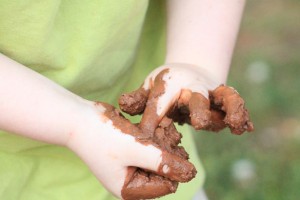Sensory play supports children’s development, learning, and eventually, their kindergarten readiness. Basically, sensory play is an activity that stimulates the senses: touch, taste, smell, hearing, and sight. In addition to these 5, there are 2 other senses which are the sense of the body’s position in space and the sense of movement. 
Many play activities will stimulate a few senses at a time and they are often very appealing to young children. Sensory play is sometimes called messy play; quite likely that’s why it’s so much fun for kids. While sensory play is the doing, it’s important to learn the words for the senses, too.
There are dozens of children’s songs, books, and videos about the 5 senses. One of the easiest songs to help kids attach the name of the body part to what it does uses the tune to Mulberry Bush and lots of repetitive words.
This is the way we taste with our tongue, taste with our tongue, taste with our tongue.
This is the way we taste with our tongue, yum, yum, yum.
This is the way we smell with our nose, smell with our nose, smell with our nose.
This is the way we smell with our nose, sniff, sniff, sniff.
This is the way we see with our eyes, see with our eyes, see with our eyes.
This is the way we see with our eyes, look, look, look.
This is the way we touch hear with our ears, hear with our ears, hear with our ears.
This is the way we hear with our ears, listen, listen, listen.
This is the way we touch with our skin, touch with our skin, touch with our skin.
This is the way we touch with our skin, feel, feel, feel.
This simple song uses a familiar tune and related words for each of the 5 senses. The meaning of each verse helps kids match the words. When possible throughout the day, you can sing the relevant verse. For instance, when eating lunch, start the verse about tasting and your child can sing along. When a big truck drives by and makes lots of noise, sing the listening part of the song and your child can join in. Getting a face washed is time for the touch verse. Ask your child what it feels like: is the water warm or cool, is the washcloth soft? Is there a wonderful smell from something, or maybe not so great? There’s always lots to see. Using bits of the song every now and then will help your child build awareness of the senses. Sometimes kids will make the connection on their own and sing independently. After a few times, you can even sing the wrong part; kids love to correct adults. Do you have some other suggestions for sensory fun?
